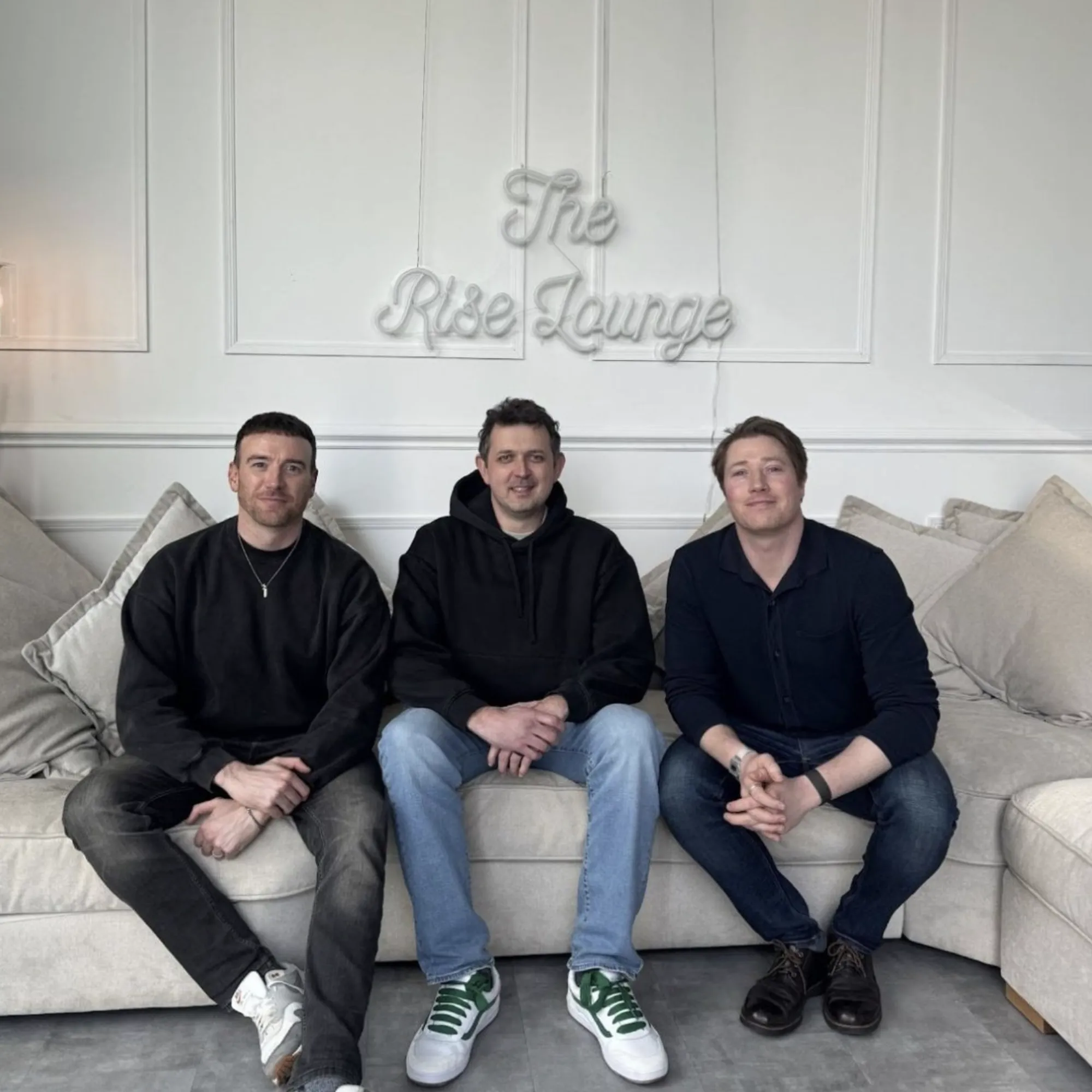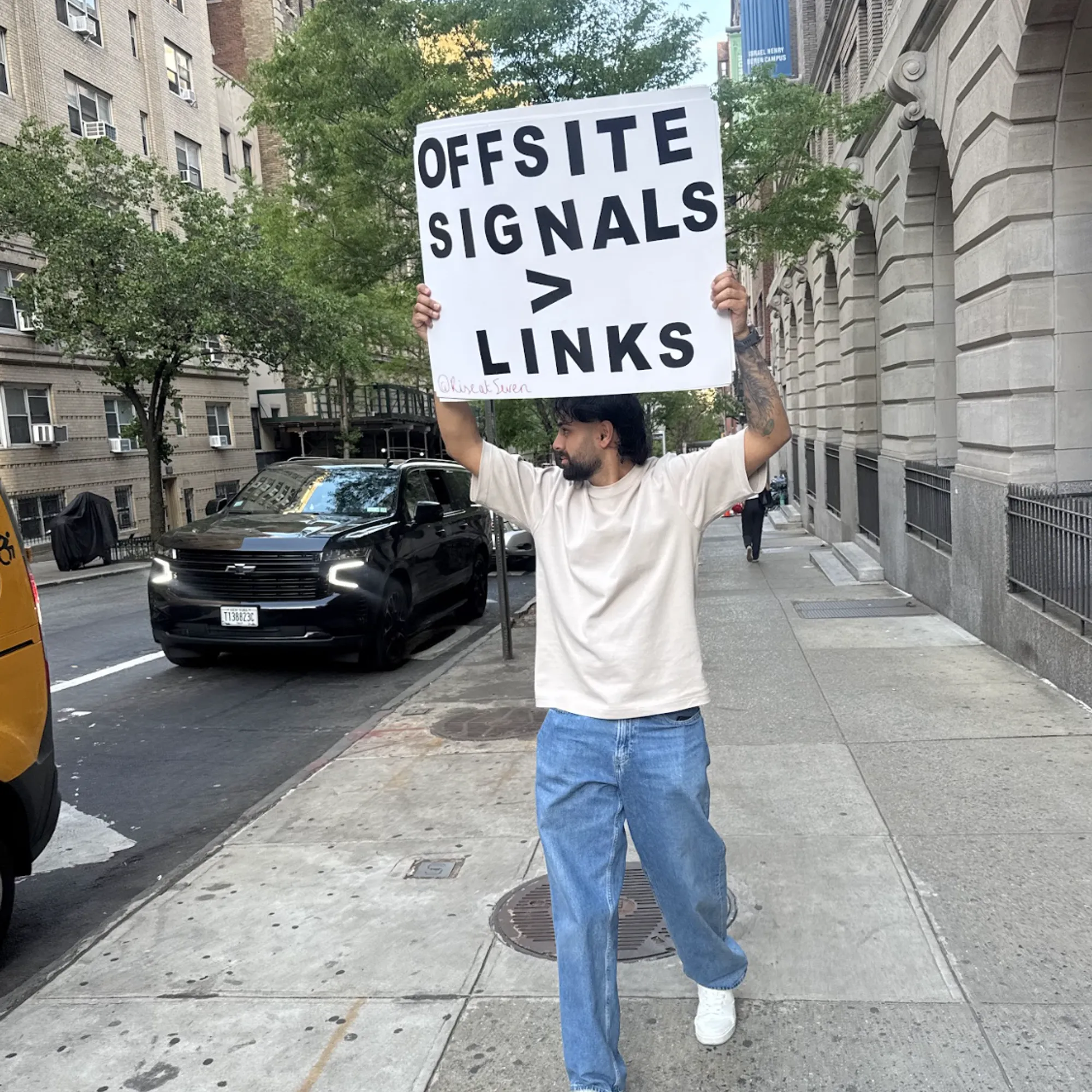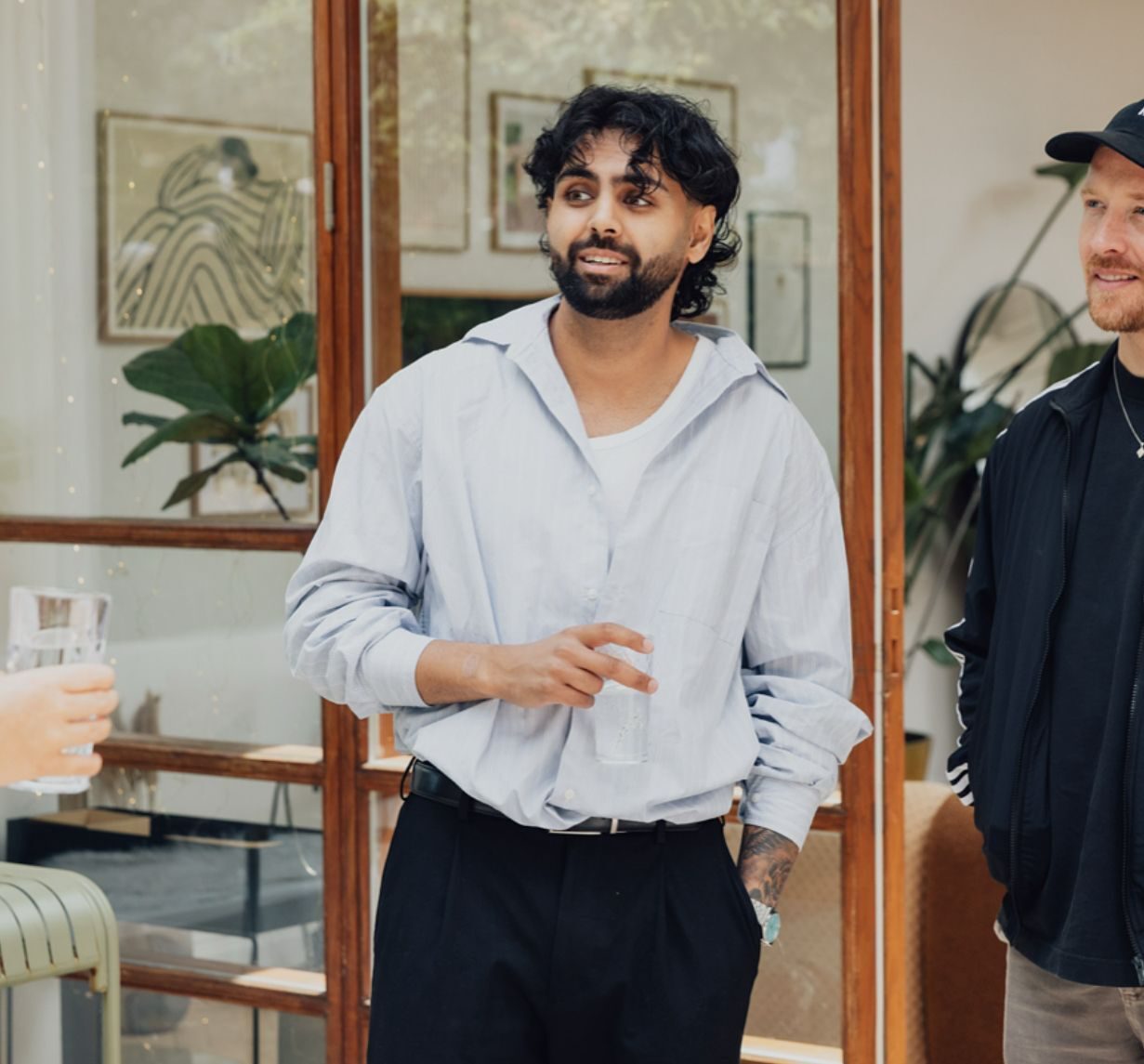Navigating Multi-Platform Search in the Age of AI Overviews, AI Mode (and other AI Curveballs)
In a world of zero click search, navigating multi platform search and the rise of conversational search on LLM platforms like ChatGPT - marketers are challenged more than ever before to help navigate this world, defend positions in terms of visibility whilst looking for opportunities to grow.
I’m Joe Struggles, the strategy director here at Rise at Seven and in this post I am going to share everything we know about how you can future proof your organic strategy in the age of AI mode and LLMs.
An honest starting point
Let’s begin with the obvious: you’ve landed here looking for information on GEO. Maybe you Googled it (we hope), or perhaps you found your way here through other channels.
There’s a lot of buzz in marketing circles around LLM optimisation — whether it's being called AIO, AEO, or GEO, or some agency-coined product term. Some are touting it as a new saviour for organic traffic in a world where click-through rates are down yet expectations are up.
But here’s the thing: LLMs are search platforms. So, logically, responsibility for visibility in this space should still sit with your SEO team — the same people already monitoring performance across platforms like Google (and hopefully others).
This article isn’t about reinventing the wheel if you already know SEO. Instead, it’s about preparing for a world where a new player — generative search — is entering the organic arena.
There are clear parallels between GEO and SEO (which we’ll outline below), but at Rise, our view is simple: GEO is SEO. As is TikTok search, Reddit search and search across other platforms. All require the same foundational approach — search-first, creative content rooted in audience intent that’s tailored to the platform the search is performed on. Just with a little more consideration and innovation involved.
First, what is Generative Engine Optimisation?
The time for AI action - How to get going with AI
Run a Generative SEO (GEO) Audit

Joe Struggles, Strategy Director, Rise at Seven
Here's some back history:
Since ChatGPT’s launched its initial prototype in November 2022, generative AI has rapidly transformed how people search, trust, and buy. It reached one million users within a week and continues to grow quickly.
OpenAI’s chief operating officer, Brad Lightcap, told CNBC that OpenAI had topped 400 million users in February 2025 — a rise of 33% in less than three months. This figure is expected to have increased further since then.
While search powered by large language models still accounts for a small but rising share of total queries (a recent SparkToro study revealed there were around 37.5 million ChatGPT searches per day versus Google’s 14 billion), it is expanding rapidly since. Brands that fail to adapt now risk missing out on a fast-growing channel altogether.
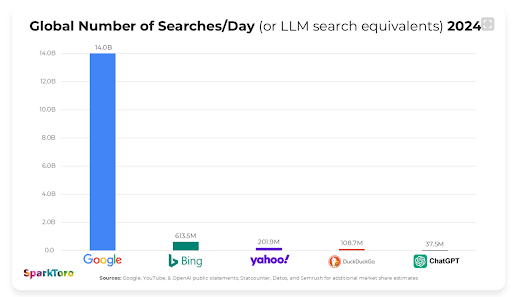
SparkToro, New Research: Google Search Grew 20%+ in 2024; receives ~373X more searches than ChatGPT
First, what is Generative Engine Optimisation?
Generative engine optimisation (GEO) is optimising your content to appear in LLM search platforms, like ChatGPT, or appear in AI Overviews. Or, quite transparently and unashamedly, here’s how Google themselves put it in their own AI Overview:
“Generative Engine Optimization (GEO) is a strategy to enhance the visibility of your content in AI-driven search results and generative AI responses, like those from ChatGPT, Google's Gemini, or Perplexity. Instead of focusing on traditional search engine rankings (SEO), GEO aims to ensure your content is cited, summarized, or featured within AI-generated outputs.”
So now you know. If you’re still confused at this point, we have made a handy AI 101 explainer deck we’re happy to send over. Just ask.
The time for AI action - How to get going with AI
This isn’t future-facing, flying car stuff - it’s already happening. Inertia breeds inertia, and now is not the time to sit back and pretend you’re on top of it - it’s time to act. Before your competitors do.
As a search-first creative agency, Rise at Seven has developed a clear and practical plan to help clients capture LLM-based search, move quickly, appear in the moments that matter, and drive real business results.
After all, the definition of SEO, according to the Big G themselves, is “helping search engines understand your content, and helping users find your site and decide whether to visit it through a search engine.”
Put simply: if a goal of yours is to “help users find your site” (drive traffic) or “decide whether to visit it” (acquisition or brand salience), then… LLMs are a form of search engine — just not the kind we typically think of.
Generative search is a live, active channel. Platforms like ChatGPT, Perplexity, and Gemini are already replacing top-of-funnel discovery. And the early movers? They’re already seeing tangible returns.
So, how does LLM optimisation — or as it’s increasingly known, Generative Engine Optimisation (GEO) — actually work?
There’s no red PPC button. No instant win (though we may be onto something with Park Dean which you can read below). Instead, we approach GEO a bit like we do organic search: with a solid technical foundation, audience-led modular content, and off-site signals that build brand authority.
This document outlines how Rise at Seven is helping brands lead in the age of generative search — showing up where it matters, staying ahead of the curve, catching the attention of the C-suite, and turning investor heads.
What’s at stake if you don’t get on top of GEO
No Google Search Console. No Helpful Criterias. No paid slots (yet, but we bet our best office dog or two they’re coming).
In generative search, visibility is earned — not bought or hacked. LLMs surface answers based on relevance, consistency, trust, and how well they understand your brand. And with AI Mode being introduced in the US and now looming over the rest of the world, an out-of-date search strategy that focuses only on 10 blue links may be at risk.
The Losers: Sites with shallow, duplicative, or over-optimised content that exist purely to game the system. They're being overtaken — fast.
The Winners: Brands with clear site structure, rich and meaningful content, and third-party validation. They're building authority and driving pipeline through a new, rapidly growing channel.
How you can win at GEO
We’ve developed a structured plan to help you gain visibility, get cited, and stay ahead of the competition. Whether your goal is to drive more traffic, increase brand awareness, or achieve something else, you can follow the programme outlined below. By embedding it into your existing channel strategy, you'll ensure you’re leveraging LLMs to help meet the business objectives defined in your north star framework, while also building KPIs in the usual way.
Here's how we do it:
Ask the audience
So, like many buzzwords in recent times, it’s easy for us marketers to roll up our sleeves and dive headfirst into the latest megatrend. Remember the metaverse? Don’t worry, we’re a bit embarrassed too.
With AI seemingly here to stay, it’s worth asking ourselves – or better yet, our customers and clients – whether AI is really relevant for your industry. Does it matter to their customers?
For some industries, it’s a no-brainer. Where search presence is crucial and audiences might use LLMs every day, brand visibility is key. As a strategist, keen cook, and gym-goer, I use AI tools daily myself.
But what about chemists or bioengineers? They wouldn’t turn to an LLM to learn their craft or to buy solvents, salts, or other specialised lab chemicals. After years of study, they go straight to trusted manufacturers.
A Datos Consumer Search Behaviour report from May 2024 found that only 16.4% of surveyed US-based search engine users had used an AI platform — an increase of 2% year on year. Still, that’s a significant and growing market.

Datos, Consumer Search Behavior: What’s Changing and What’s Not in the Age of AI?
And what about delivery drivers or artisans? They’re more likely to rely on local search, word of mouth, or practical recommendations than AI chatbots. For them, local visibility and search and community presence probably matter more than AI-driven tools. So we may advise a different strategic approach.
So, if you’re still convinced AI is a vital part of your marketing toolkit or your client’s strategy (and it probably is if you are reading this), read on to find out how to use it effectively.
Run a Generative SEO (GEO) Audit
Check your presence in LLMs today
Before you make a move, it’s crucial to understand how your brand is currently showing up — if at all — in AI-powered search results. This means assessing not just your visibility, but also how you compare to the competition. Here’s where to start:
- Appearance in LLM platforms (ChatGPT, Perplexity, Claude, Gemini, etc.)
- Crawl access and bot behaviour (e.g. GPTBot, ClaudeBot)
- How you're described vs competitors
- Referral traffic from known LLMs via GA4 regex tracking
Understand how you appear in LLMs now:
First things first, just as you would Google your own brand (or name, admit it), you want to see how you appear for some of your core target search queries. You could ask yourself:
- Do we appear for category-defining or product-specific terms?
- How are we described?
- Are competitors getting mentioned when we’re not?
Crawl Access: List of priority LLM platforms, chatbots and server bots:
Many LLMs and AI platforms send bots to crawl your site. Ensuring your content is accessible — and that you're not unintentionally blocking them — is key.. You can find the details to do this in the section below:

Check LLM referral traffic in GA4 using filters and referrers
To monitor AI-driven sessions in Google Analytics 4, use a referrer regex filter to match known LLM and AI assistant platforms:
(chat\.openai\.com|claude\.ai|gemini\.google\.com|bard\.google\.com|perplexity\.ai|perplexity\.page\.link|you\.com|copilot\.microsoft\.com|bing\.com|grok\.x\.com|meta\.ai|huggingface\.co|poe\.com|phind\.com|writesonic\.com|ora\.sh|pi\.ai|reka\.ai|zapier\.com|notion\.so|flowgpt\.com|nat\.dev|agent\.gpt|ai\.fb\.com)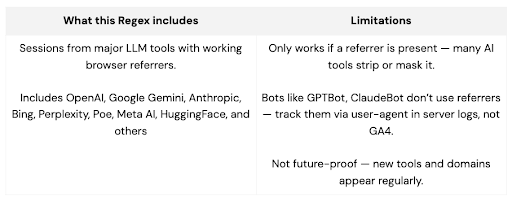
This will help you:
- See how much traffic is coming from tools like ChatGPT, Claude, or Gemini
- Have a play to understand content that works well or split by audience insight or demographic
- Track user sessions that originate from generative platforms
- Benchmark changes over time as your GEO strategy develops
AI Overviews: A robot v robot battle
Has Google come to take ChatGPT's lunch money by introducing AI Overviews and building its own version of BERT? Probably. Platforms like Bing, which recently introduced AI summaries of their own, have also started to follow suit. So we’re seeing a battle between AI bots. But don’t worry, we can help there too – we’ll make a Sarah Connor of you yet.
You can use tools like AHREFs, SEMrush, and others to understand which terms trigger AI Overviews (formerly known as Search Generative Experience) and which don’t, as well as how often your site appears in them and where your traffic is coming from.
Using Keyword Research to check AI Overviews
A keyword research document includes a list of target search phrases a business wants to rank for. Many modern tools now display SERP features, and many of them include AI Overviews, which detail the visible URL along with other useful metrics like monthly search volume, keyword difficulty (how competitive a keyword is), and more. You can use this information to spot gaps—identifying where AI Overviews appear (and trying to get in on those) or where they don’t (and attempting to rank there before others do).
If any of this has left you confused and you have no idea what the above means, feel free to email us for clarification, and here's a guide on keyword research to help get you started.
How to check how often your site appears in AI Overviews
Tools like AHREFs also allow you to check how often your brand appears in AI Overviews. Although this feature is still in BETA, it can show you what you're already well-known for, providing a good benchmark to work from. Whether you want to adjust things that aren’t quite hitting the mark or capitalise on something you’re already renowned for, this is a great way to get insights into your brand’s visibility.
Again, you can do all of this in the auditing phase of things.
Build a Rollout Plan for GEO
Once you know your current position, begin proactive optimisation. Here's what to do:
Tactics for on-site:
Strong on-site signals, including branding
At Rise, we believe the brands with the largest brand and category signals - those with established domain authority, a clear brand identity, and strong semantic relevance -are best placed to succeed in the age of large language models (LLMs).
And where else do LLMs harvest their content than from your website and other mentions elsewhere, like social, PR etc?
These companies naturally gain more visibility in AI-generated content, thanks to their market presence and longstanding credibility.
We understand this may not be the most encouraging message for start-ups and smaller businesses - but every brand has to start somewhere.
The good news? The very foundations that support visibility in LLMs — brand clarity, targeted keyword strategies, and audience alignment—are also the building blocks of any well-executed SEO and digital marketing strategy. And that’s exactly where we can help.
Let’s start building your brand authority from the ground up.
Adding an LLMs.txt file
LLMs.txt supposedly work in the same way as a robots.txt file - they let Google know who you are, what URLs to crawl and what not to. Though speculative with no real proof to date that they do or don’t work, we want to provide you with a blanket of recommendations so you can sleep at night knowing you’re doing all you can to please those LLM bot overlords.
A few things on LLMs.txt:
- Align it with your robots.txt: This tells them which URLs not to crawl. Also, remember not to block the above crawler bots in your robots.txt.
- Align it with your sitemap.xml: This tells LLMs which content to crawl and gives them an idea of your website’s information architecture and URL hierarchy.
- You can also check if your competitors have these too.
- We’d recommend adding context as to who your business is in the description.
Again, this is unproven territory, the second most ‘unprecedented moment’ this century after COVID. But if we want to lead the way in generative search, we have to be willing to test, learn, and iterate.
Schema Markup: Make it easy for LLMs to understand you
A talk at SMX Munich in October 2024 discussed LLMs actively use schema markup to interpret websites more efficiently. And why wouldn’t they? Schema is an existing, structured framework that tells machines exactly what they’re looking at. It’s smart — and it’s there to be used.
Some key schema recommendations:
- Add sameAs schema: This helps LLMs disambiguate your brand from others with similar names. Link to your social profiles, Wikipedia, and authoritative listings.
- Ensure structured product data is in place: Include pricing, reviews, stock availability, and other relevant attributes to enhance clarity and usability.
- Improve consistency in product and category descriptions: Make sure the structured data matches your on-page content to avoid confusion or dilution.
- Use the Schema Library wisely: There are thousands of schema types available in the Schema Library. Think about what information might be valuable to surface to users — then find the markup that fits.
If you need help setting up or auditing your schema implementation, get in touch with Will from our Tech SEO team — we’re here to make it easy. He’s generally a lovely chap and happy to chat.
Off-site tactics:
We’ve said it before, and we’ll say it again – digital PR is the way forward here. Not only do LLMs pull content from your site, but they also take it from other sites too. In a similar vein to brand authority and referring domains in a backlink strategy sense, it bodes well to build authority off-site too. To do this, you could:
- Encourage high-quality product reviews on trusted, structured sites.
- Boost PR presence on publications that AI models cite frequently.
- Use social media and forums to increase brand mentions in training data sources.
- Monitor sentiment and citations — your brand's tone and positioning can affect how it appears in AI-generated answers.
- Work with influencers on a programme that raises E-E-A-T credentials
If you need help with off-site marketing, including Digital PR, get in touch with Kate from our Digital PR team.
Special mention: Treat Generative Search as a live channel
This isn’t future-facing — it’s already happening.
With memory integration for Pro and Plus users, ChatGPT is now personalising responses. LLMs are beginning to mirror user behaviour seen on platforms like Google, TikTok, and Reddit — but with curated, AI-synthesised answers.
And with the recent addition of in-platform shopping, ChatGPT is becoming a direct commercial channel. From eCommerce giants to SME startups, businesses need to take notice.
Stating the obvious - isn’t this just like standard SEO?
Much like SEO, websites and brands that adopt best-practice approaches early will get ahead of those that kick tyres. As Google themselves put it: “SEO is about taking the next step and working on improving your site's presence in Search”.
Yet despite launching a dedicated landing page, Google’s official advice is vague at best:
“Focus on unique, valuable content for people…”
“Provide a great page experience…”
It’s essentially a rehash of the Helpful Content guidelines.
Much like traditional SEO, the early adopters of best-practice content and site optimisation will always get ahead of the tyre-kickers. Even with Google’s recent guidance on optimising content for AI discovery, the advice is — unsurprisingly — not all that different from what we've heard before. And rightly so. We’re still creating content for people, not machines.
So let’s agree – LLM optimisation = SEO.
Happy? So are we.
How is SEO and GEO different?
SEO and GEO are kinda similar, but very different. Coming at both with the same program might be like trying to eat a yoghurt with a ladle. You need the right tool for the job, otherwise you might make a bit of a mess of things.
One clear difference is there’s currently no equivalent to rankings or paid ads (yet — though Google recently announced they’re “expanding ads into AI Overviews” at Content Marketing Live in May). If you’re feeling brave, you can even categorise it as Organic in GA.
There’s also no Google-style framework — no Search Essentials (formerly Webmaster Guidelines), no Search Console, and no predefined set of criteria to follow, though Google did update their Search Essentials to include some “top ways to ensure your content performs well in Google’s AI experience”. Helpful? Definitely. Trustworthy? We’ll have to see…
Instead, presence is earned through relevance, consistency, and brand authority — especially in how large language models (LLMs) interpret and surface your brand in responses.
As LLMs like ChatGPT and Gemini increasingly shape the way users discover and interact with content, your brand’s presence in AI-generated answers is becoming as critical as its ranking on traditional SERPs.
Here are a few examples of how how traditional SEO compares to this new landscape:
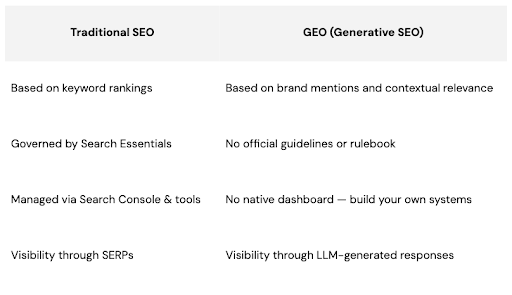
What This Means:
A few quick obvious observations:
- It’s not just about visibility — it’s about brand representation
- There’s no Search Console-style dashboard — so you'll need to develop your own models for tracking, attribution, and performance inference.
- Early investment builds early trust — once LLMs “learn” your brand, that trust can compound over time.
For instance, if your brand is frequently cited across credible sources and presents a consistent identity, LLMs are more likely to surface your content in relevant contexts — even without traditional backlinks or structured markup.
So yes, there are clear parallels — and that’s exactly why we, a search-first agency, are showing you how to align your strategies to succeed in both spaces. Winner winner…
Case in Point: Parkdean Resorts
Rise has seen success here firsthand. Parkdean Resorts is consistently surfacing in AI answers — especially around seasonal travel searches like Easter breaks.
Why? Here are three things we did:
- Content quality and structure: we’ve optimised how their pages are labelled and how content is presented to AI.
- Relevant link building: ongoing organic link placements in publications and places where LLMs take their information from.
- Strong brand association: there’s significant search demand around [Parkdean + Easter breaks], likely influencing AI trust.
For clients like Parkdean, GEO isn’t a hypothetical — it’s a measurable advantage in generative search.

Here’s what we achieved:
- Parkdean now appear in 750 AI Overviews (+680% since Jan 2025)
- This is a combined search volume on of 46K UK searches per month
- Highlight keywords include
- ‘easter breaks UK’ (1.6K UK searches per month) alongside a No. 1 ranking position
- ‘May half term breaks (2.4K), now ranking in No. 3
- ‘Cornwall holiday’ (1.2K, no. 3)
Parkdean now have significantly more AIO’s appearances than key competitors, such as HoSeasons (92%) and Haven (25%). Overall, “a solid result of continued excellent link acquisition efforts”, according to account strategist Andrew Parker (AKA Beans).
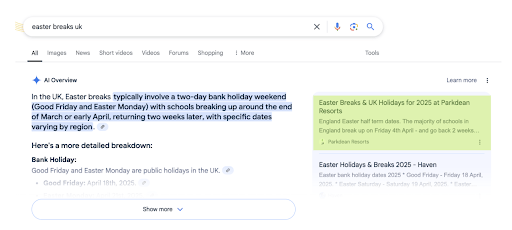
What Makes Rise Different
- We’re running GEO experiments daily across a number of brands, including travel, retail, and finance and others
- We’re up for a test – if you disagree, tried things yourselves or need help, let us know!
- Our frameworks blend SEO, digital PR, and AI prompt engineering
- We’re not theorising — we’re getting results
Key Takeaways
- LLMs are search engines. Optimise like they matter now, because they do.
- Run visibility audits, monitor traffic, and roll out technical and off-site updates.
- Focus on structured, relevant, reputable content — that’s what AI leans on.
- Treat this like a new channel and a test. Because that’s exactly what it is.
Need help auditing or rolling out your GEO and LLM optimisation plan?
LLMs are search engines. Optimise like they matter — because they do. And the more channels that can be used to help us achieve our (and our client’s) goals, the happier we are.
We’re here to help you do just that. From audits to ongoing support, we’ve got your back. We’re helping clients now with technical setup, tracking, visibility optimisation and AI appearance benchmarking.
All we need to get started is access an email in our inbox or a quick call, let’s chat.

